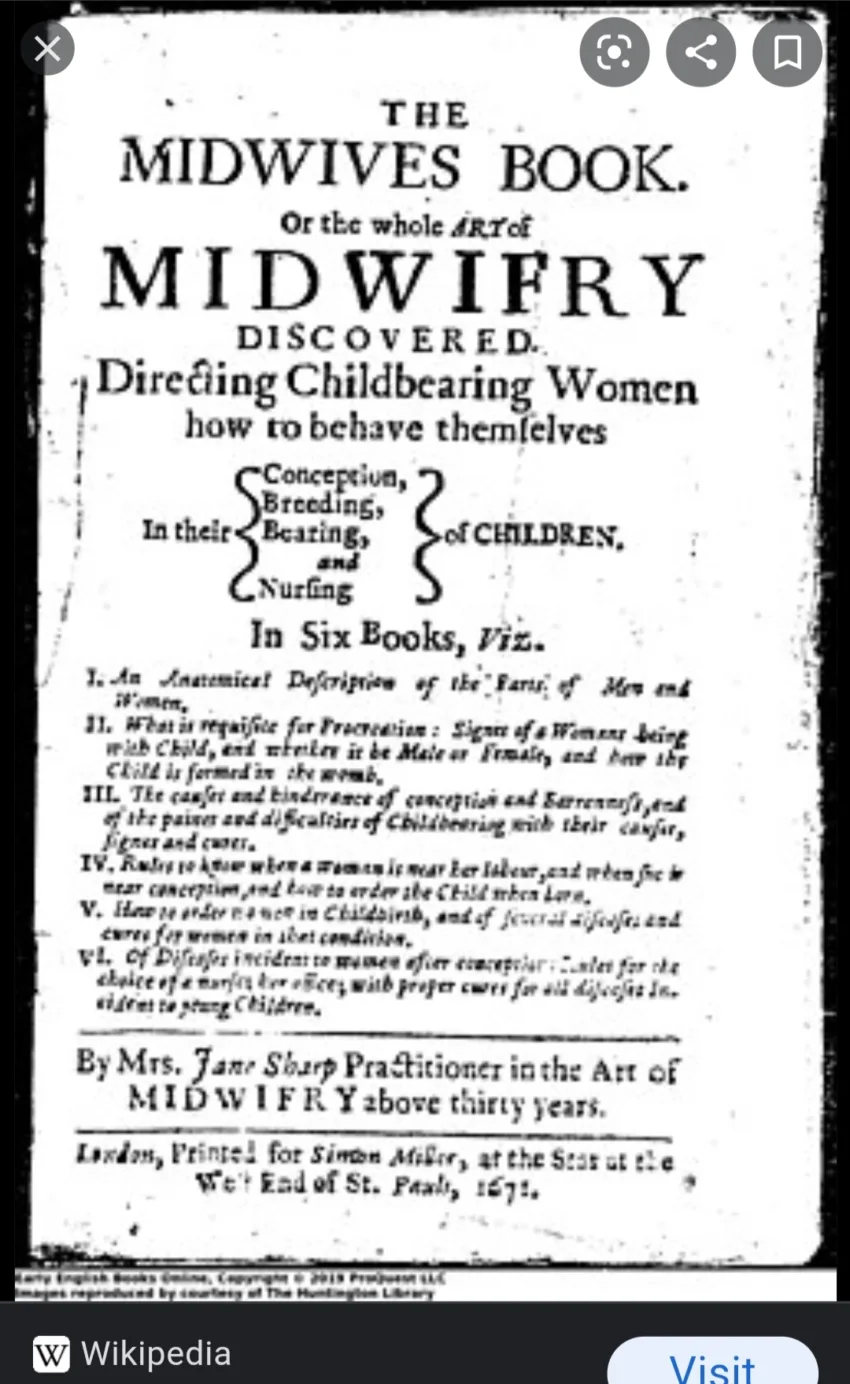1196: Jane Sharp
Pioneering Midwife and Author
Born: Most Likely 1610s/1620s, Present-day England, United Kingdom
Died: After 1671, Most-likely Present-day England, United Kingdom
Jane is known for having written the first book on English midwifery to be written by a woman. When she published the book in 1671, Jane described herself as a midwife with over thirty years of experience. The book was called Midwives Book: or The Whole Art of Midwifery Discovered and appeared in four editions, with the last update being published in 1725.
By 1700, aside from Jane’s manual, nearly all written works on the science of midwifery were theoretical texts written by men with little to no actual midwifery experience. Practicing midwives usually learned on the job and had no trustworthy texts to read from. Jane’s book began to change that.
Jane’s book covered six different sections, or topics, which went beyond the straight confines of midwifery. Though some of the knowledge is wrong by today’s medical standards, for the time period it was incredibly all-encompassing. Jane’s book included information on female and male reproductive anatomy, conception and addressing problems with conceiving, fetal development, childbirth itself, complications that can arise during a birth, and advice to mothers for caring for the newborn in the months following the birth. The manual even went on to give nutritional advice, tips on breastfeeding, and how to care for common childhood illnesses.
Jane’s book also had underlying feminist themes. She discusses her frustrations with the lack of education available to women—how they were barred from attending university classes, were unable to learn the sciences, and how most science and anatomy textbooks were still being written in Latin or Greek, languages the vast majority of women (and to be honest, most men) did not know and could not read. At one point she even states that she believes midwifery should be a solely female held position. While men were able to learn textbook knowledge on how to help women in childbirth, Jane pointed out that women know their own bodies better than men and midwifes with practical on-the-job training were much more useful in emergent situations than men with a university degree. That is also why Jane urged midwives to take up their own surgical and medicinal training, so that they would not have to rely on male physicians.
According to the Heroine Collective (article linked below), Jane’s feminist writings also went beyond the scope of midwifery. As stated in the article:
“Perhaps rather unexpectedly for a work dating from the 17th Century, Jane’s book contained a vivid portrayal of female sexuality. She emphasised the significance of clitoral stimulation, believing that the female climax was an important aspect of conception. Unlike her male contemporaries who wrote about female anatomy in a very negative and derisory way, depicting women’s bodies as inferior to men’s, Jane celebrated the marvels of the female body. She wondered at the ability of the vagina and cervix to open, close or expand as necessary and extolled it as “The works of the Lord”.”
Another aspect of childbirth Jane placed great emphasis on, and which she differed wildly from male counterparts, was that the mother needed to be comfortable while giving birth. Most male physicians (and, let’s be honest, hospital workers today! At least in the United States) demanded a mother giving birth should be stuck in one specific position while giving birth. Jane disagreed wholeheartedly, and insisted a mother should be allowed to move around the room and also choose what position was most comfortable for the mother in order to facilitate an easier birth. Jane also added that under no circumstances should a physician try to hasten a non-emergent birth, and that mothers should be allowed to eat or drink to keep up their strength if they so wished.
Immediately after the birth, Jane also advised continuing to care for the mother’s physical and mental wellbeing. As she stated, the poor woman had just been through excruciating pain, and needed extra care that male physicians were likely to ignore. All of these reasons added up to Jane’s book being wildly popular, and as she hoped for, changed the field of midwifery forever. While men continued to dominate the sciences for centuries onward, Jane’s manual helped break open the path for women to become more prominent midwives, and later physicians, helping their fellow women through the most natural of all bodily functions, welcoming a new child into the world.
Midwives of Jane’s era could usually read but being able to write—especially at the level needed to publish an instructional manual, was unusual. The book also had drawings made by Jane herself, to further illustrate her points.
Jane said in the book:
“To the Midwives of England: Sisters, I have often sat down sad in the consideration of the many miseries women endure in the hands of unskillful midwives.”
Sadly, no other biographical information about Jane is known today. There are no records of her obtaining a license from the church to practice her skill, but that was not uncommon for her time. Historians have no idea when she was born or when she died; we have no idea if she was ever married or had children of her own. All we know is that she was a woman ahead of her time. She was educated in both practical sciences as well as reading and writing. But what we know more than anything, is that Jane wanted women to have better opportunities going forward, not just for more successful outcomes during a pregnancy, but also in their professional careers.
Jane’s book can be purchased on Amazon today. Of course, they are not first edition copies by any means, but still copies are available. When I checked the listing (here) hardback copies were almost $200 and paperbacks were between $40 and $65.
Badges Earned:
Located in My Personal Library:
Uppity Women Speak Their Minds by Vicki Leon
Sources:
https://huntington.org/educators/learning-resources/spotlight/midwives-book

